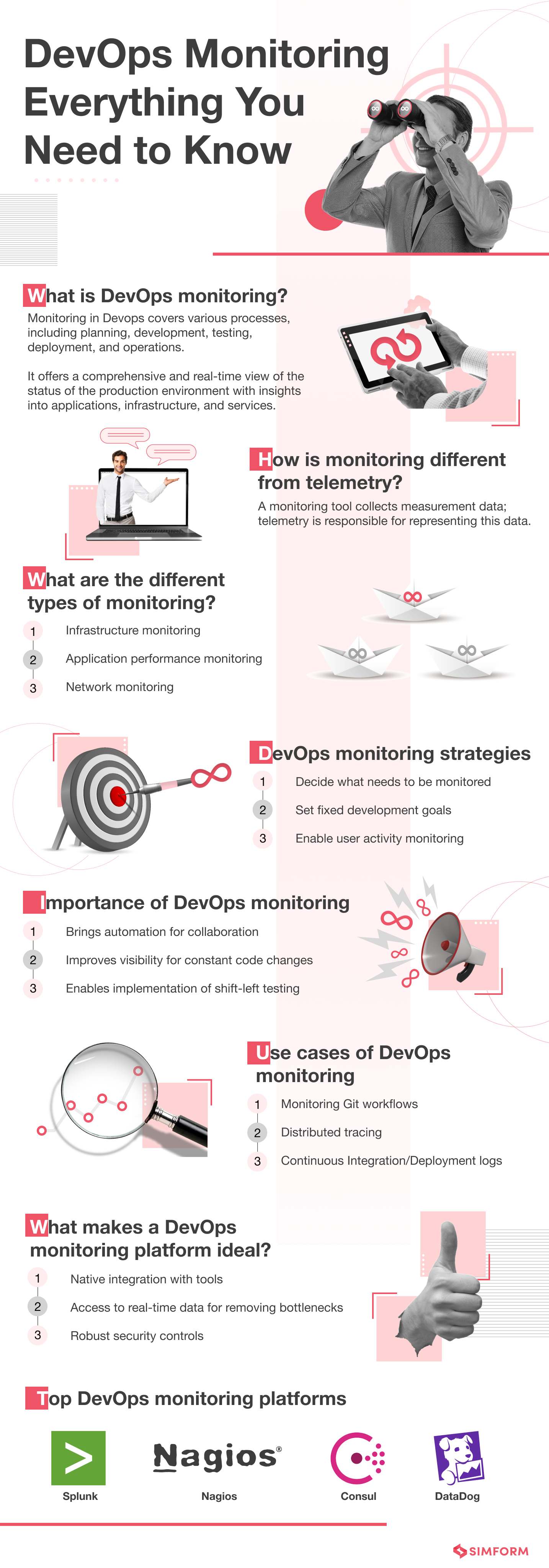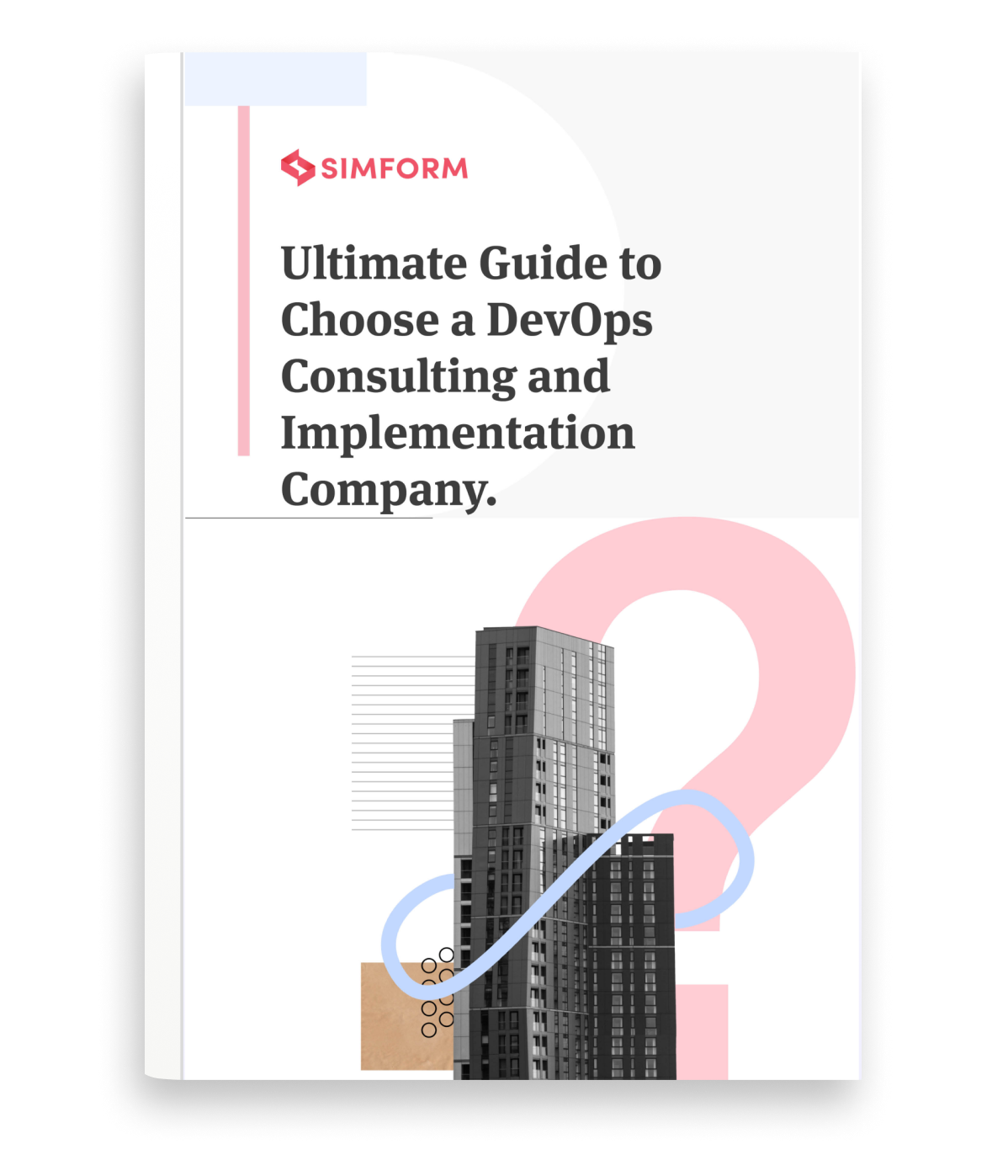Ever wondered why monitoring is essential?
On 25th Feb 2022, British Airways faced an IT outage, causing hundreds of flight cancellations and disruptions in its operations. Due to unresponsive servers, British Airways had to pay each customer £220 or £350 in cash. Taking a few proactive and calculated steps could have minimized the impact of downtime. For instance, monitoring systems could have prevented such a catastrophic event.
However, monitoring not only prevents downtimes but brings multiple other benefits to an organization and improves the processes for your development teams.
This article focuses on DevOps monitoring, implementation, best practices, use cases, and top tools you can leverage per your business needs. So, let’s begin with the basics!
What is DevOps monitoring?
Monitoring in Devops covers a diverse range of processes, including planning, development, testing, deployment, and operations. It offers a comprehensive and real-time view of the status of the production environment with insights into applications, infrastructure, and services. Collecting data from logs and metrics allows you to observe performance and compliance at each stage of the SDLC pipeline.
How is monitoring different from telemetry?
When a monitoring tool collects measurement data, telemetry is responsible for representing this data. It performs the function of an agent providing specific monitoring data and real-time alerts for important events and crucial information related to resource utilization. DevOps requires continuously measuring application health and performance, and telemetry always provides these metrics on the dashboards.
Different Types of Monitoring in DevOps?
-
Infrastructure monitoring
An organization that relies on Information Technology for delivering its products and services requires setting up and maintaining an IT infrastructure. This infrastructure includes everything from networks, servers, computer hardware/software, data centers, and storage. By monitoring the IT infrastructure, you can collect and examine information obtained from it and use the data to enhance final outcomes. It includes monitoring hardware, application, OS, and the network. Popular infrastructure monitoring tools include Prometheus, ManegeEngine, and Solarwinds.
-
Application performance monitoring
By monitoring an application, you can gain runtime metrics on how your application performs, including app uptime, security and log monitoring, and overall app performance. APM tools such as DataDog, Uptrends, and Splunk are widely used to generate transaction volume and time metrics, API responses, backend application health, and more. Typically, these metrics are delivered after evaluating the application performance and overall infrastructure in the form of graphics and statistics.
-
Network monitoring
It tracks everything about the network, including routers, servers, VMs, firewalls, etc. Network monitoring is responsible for identifying faults, measuring the performance of these elements, and optimizing their functionality. A dynamic network monitoring system can help avoid downtimes and failures before affecting performance. A list of popular tools includes Cacti, Spiceworks, and Wireshark.
-
Synthetic monitoring
It uses user behavioral patterns to simulate fundamental end-user interactions with applications or websites. Synthetic monitoring helps understand how users perceive a particular application or website and the system’s performance, speed, and functionality.
Various synthetic monitoring tools available in the market, such as Sematext, Pingdom, New Relic, SpeedCurve, etc., can help you take advantage of the synthetic monitoring functionalities. It also establishes a performance benchmark for the future and enables you to keep the peak performance intact.
-
Cost monitoring
DevOps pipeline involves a lot of changes that could cost significant money, so tracking down the cost of your operations is paramount. Most infrastructure resides in the cloud; therefore, controlling its price is essential for profitable business operations. Monitoring cost involves continuous tracking of resource usage.
For that purpose, you can use various cost monitoring metrics that help you to detect exact costs per unit and customer. With these metrics in play, you can forecast the total cost and optimize resource utilization throughout various phases of DevOps. Amazon Cloudwatch, CloudZero, Azure Cost Management, ParkMyCloud, etc., are popular cloud monitoring tools.
What are the best DevOps monitoring strategies?
-
Decide what needs monitoring
Before going into details, it is important to know what needs to be monitored to make the most of your efforts. The monitoring goals should focus on the server’s health, vulnerabilities, user activity, and application log output.
-
Set fixed development goals
These goals are indicative of how well your DevOps monitoring strategies are working. It also helps obtain insights into how efficient your workflow is and how well your teams perform. A proven way of ensuring these outcomes is to record the duration of each sprint and the average time taken to identify, document, and fix bugs. Consider using machine learning to effectively automate configuration tasks and save significant time.
-
Enable user activity monitoring
One of the essential monitoring types, user activity monitoring, can help mitigate cyberattacks and potential threats to the system. It is important to track unusual requests, multiple login attempts, or log in from unknown devices and suspicious activities like a developer accessing the admin account. By monitoring the user activity, you can ensure that only the authorized users have entered the system and make your application more reliable for your users.
-
Pick the right monitoring tools
Choosing a monitoring tool that meets your goals and requirements starts with an evaluation process. It primarily involves understanding the functionality of each tool and learning if the tool is best suited for application or infrastructure monitoring to make the right decision.
Why is DevOps monitoring important?
Proper system monitoring provides valuable insights, enabling you to view every component in your application stack with the help of API-driven code. Also, when code hooks are embedded into the application logic, it augments the monitoring process.
Devops monitoring is inherently proactive, and as a result, it identifies the gaps and opportunities to improve the application performance before the bugs are visible. Monitoring also improves the DevOps toolchain by highlighting where automation may be beneficial. It encourages DevOps teams to use third-party tools for deployment, ticketing, altering, and more, offering more advanced complex application features.
Here are three common but significant benefits of DevOps monitoring:-
-
Brings automation for collaboration
The core principle of DevOps is improving collaboration between the development and operations teams. However, if there is an absence of integration between tools, coordination between teams may hit a wall. Therefore, you can leverage automation to enable a unified view of the entire development pipeline or track commits and pull requests to make records of Jira issues and notify the development team on their preferred communication channel.
-
Improves visibility for constant code changes
The complexity of a production environment increases as CI/CD enables developers to make frequent changes to their code. Moreover, micro-services and micro frontends have introduced thousands of moving parts in a workflow, where every part operates at a different scale and observes different latency and redundancy. As a result, complete visibility into the ecosystem is crucial for teams to mend any damage done to the user experience in real time.
-
Enables implementation of shift-left testing
Shift-left testing can improve quality, reduce test cycles, and decrease errors when performed at the beginning of the lifecycle. It also makes it easy to streamline monitoring the health of your pre-production environments and implement it before and more often. Early monitoring also helps assess how the application behaves by tracking user interactions essential for maintaining performance and availability before the application is deployed in production.
Use cases of Devops monitoring
There’s no doubt that DevOps monitoring brings significant benefits to any organization. However, implementing it effectively will ensure complete success. Here are 5 use cases of DevOps monitoring that can be leveraged by organizations without requiring their development teams to go out of their way to achieve success.
Monitoring Git workflows
When multiple developers handle the same project functionality, there are higher chances of recurring codebase conflicts. Git helps manage and resolve conflicts, which also includes commits and rollbacks. Monitoring Git workflows enables you to keep track of conflicts and maintain consistent progress in your project.
Distributed tracing
Microservices applications require distributed tracing to streamline monitoring and debugging processes. When your teams understand how the applications interact with each other through APIs, it becomes easier to detect and repair issues. Moreover, distributed tracing is also crucial in optimizing app performance and identifying bottlenecks.
Continuous Integration/Deployment logs
With the growing adoption of CI/CD pipelines in development ecosystems, monitoring them is crucial for a healthy system. CI logs inform you about the errors or warnings in your code builds. Monitoring them ensures the identification of potential challenges in your build pipeline, so your team can address them on time. Similarly, monitoring CD logs generate reports on the development pipeline’s overall system health and status. It helps you troubleshoot any failed deployments and also repair potential issues.
Configuration management changelogs
Configuration management changelogs offer insights into the system’s health and vital changes. Monitoring these logs will provide you access to changes made to the system – manual and automated, to view unauthorized changes and repair damages.
Code instrumentation
Code instrumentation is adding code to an application that collects data about its performance and operations route. It is key to tracing stack calls and viewing contextual values. By monitoring the instrumentation results, you can determine the efficiency of your DevOps practices and identify potential gaps that need urgent attention and improvements. It’s also important to detect bugs and enhance testing.
Code linting
Code linting tools help you analyze your code for style, syntax, and potential errors, including coding best practices and standards. One of the significant benefits of these tools is that it helps find and fix problems in your code before they become a runtime error. Lastly, code linting keeps your code clean and consistent.
Infrastructure deployment logs
Infrastructure deployment logs track the new stacks whenever they’re deployed. It checks whether new infrastructure deployments have failed or been carried out successfully. These logs also help identify issues or unauthorized changes in your IT infrastructure that may have led to potential deployment failure.
How Capital One implemented a DevOps strategy to stay ahead of the curve
What makes a DevOps monitoring platform ideal?
When choosing a solution for DevOps monitoring, you need to consider features that will allow you to make the most of your investment. More importantly, complex applications need to be updated multiple times a day. Therefore, an advanced monitoring system is vital. Such a system must support Docker, traditional and modern toolsets, and frameworks. It should also have the top programming languages like Ruby, Go, Python, and PHP.
The platform should seamlessly integrate into your workflow and be compatible with the tools your team leverages. They may include, but are not limited to:
- CI/CD pipelines
- Cloud infrastructure
- Version control
- Application development tools
- Communication tools
An ideal monitoring platform should be able to:
- Offer native integration with tools used in your development workflow.
- Provide access to real-time data for quick detection and removal of bottlenecks.
- Improve communication and build robust security controls.
- Generate viewer-friendly reports and dashboards.
- Deliver historical trends and risks and show the correlation between different events.
Top 12 DevOps monitoring tools you can leverage for your applications
#1. Splunk
It is a paid tool that enables accessing and using machine data for development teams. Some of its key features include:-
- It searches, analyzes, and visualizes machine data produced by different components of an IT infrastructure.
- Provides a unified view of different IT services and easy navigation between infrastructure monitoring, log monitoring, and APM.
- Offers automated continuous monitoring, real-time monitoring of all stages of a development lifecycle, and contextual logs for faster deployments.
#2. Datadog
A paid monitoring service, DataDog is a SaaS platform that offers monitoring services for servers, applications, tools, databases, and services. Some of its key features include:-
- Provides 500 vendor-supported integrations and services like turn-key visibility in app and infrastructure components.
- Helps in implementing Autodiscovery to automate the configuration of monitoring checks.
- Offers a unified view of logs, traces, and metrics generated by the application and infrastructure components.
#3. Consul
It’s an open-source monitoring tool used to discover and configure services in any infrastructure. Some of its key features include:-
- Enables the creation of a central registry for real-time tracking of services, health statuses, and updates.
- Facilitates authorized and authenticated service-to-service communication.
- Allows automation of networking tasks to reduce the burden on your developers.
#4. Monit
Another open-source DevOps monitoring tool, Monit, is created for monitoring UNIX OS. Some of its key features include:-
- Includes HTTP(S) interface for browsing the Monit server to check the status of your monitored services.
- Provides updated Monit manual for ease of operation.
#5. Nagios
It’s an open-source DevOps Monitoring tool that identifies and resolves problems with network and infrastructure. Some of its key features include:-
- Provides server monitoring services with agent-based and agentless monitoring and 5000 add-ons available.
- Offers network monitoring services to quickly detect network outages and protocol failures and maintain audit and regulatory compliance.
#6. Prometheus
It’s a free software application primarily used for event monitoring and alerting. With the help of the HTTP pull model, Prometheus can record real-time metrics in a time series database. Some of its key features include:-
- A multi-dimensional data model with time series data as key/value pairs.
- PromQL, a flexible query language to support multi-dimensionality.
- There is no need to rely on distributed storage.
#7. Zabbix
It’s an open-source monitoring tool that examines real-time network traffic, services, applications, clouds, and servers. You can run it on-premise or in the cloud. Some of its key features include:-
- Allows detecting a high-performance problem in real-time.
- Enables you to collect metrics from various sources.
- Allows creating flexible widget-based dashboards.
#8. Sensu
The monitoring as a code solution provided by Sensu conducts health checks, incident management, self-healing, alerting, and OSS observability across multiple environments. Some of its key features include:-
- A highly scalable and secure monitoring platform.
- Provides comprehensive alerting and incident management systems.
- It can easily integrate with other DevOps monitoring solutions.
#9. ChaosSearch
If you’re comfortable with Amazon S3 or Google Cloud Storage buckets as your backend storage system, ChaosSearch is your monitoring tool. It can collect, aggregate, summarize, and analyze metrics and logs. Some of its key features include:-
- A highly secure platform with Single-Sign-On (SSO) and Role-Based Access (RBA).
- Provides multi-model access for logs, SQL, and machine learning (ML).
- A fully managed monitoring solution that requires zero maintenance.
#10. Sematext
It’s an all-in-one monitoring solution designed for DevOps teams that requires examining both front-end and back-end logs, performance, APIs, and the health of the production environment. Some of its key features include:-
- Allows setting up log management and synthetic management workflows.
- Provides numerous integrations for the collection and reporting of metrics and events.
- It enables you to correlate container metrics and logs for faster troubleshooting.
#11. Elastic Stack (ELK)
ELK stands for ElasticSearch, Logstash, and Kibana. Another DevOps monitoring tool helps you store, search, and analyze data from multiple sources. Some of its key features include:-
- Allows indexing any kind of heterogeneous data with utmost ease.
- Comes with automatic node recovery and data rebalancing capabilities.
- Provides automatic alerts in case of any issues in the stack.
#12. Akamai mPulse
It’s a popular Real-User Monitoring (RUM) tool that enables DevOps teams to collect and analyze the user experience and behavior for a particular website or application. Some of its key features include:-
- Provides an in-depth analysis of user behavior patterns.
- Effortlessly monitor and visualize the impact of third-party tools.
- Integrates with popular Single-Page Application (SPA) frameworks.
Conclusion
As software development becomes more complex and nuanced, monitoring systems must evolve accordingly and match the pace of DevOps deployments. Choosing the best monitoring solution that recognizes the many moving parts of an application and how they function together can be a seminal decision for your future development projects. Therefore, hiring expert service providers is recommended to ensure you take the right step at the right time to get the best ROI.
Simform offers DevOps consulting services to organizations that either need to adopt the methodology from scratch or revise their adoption approach. Our experts will collaborate with your team with the following services:
- DevOps automation
- DevOps implementation services
- AWS DevOps services
- DevOps release management
Get in touch with us today to know more about how we can help you!
Bonus Infographic





